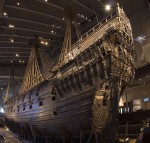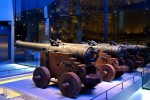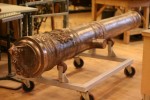 In late 2012, the Vasa Museum in Stockholm, home of the beautiful but unstable flagship of the Swedish fleet that sank a mile from the shore on its maiden voyage in 1628, put together a team to recreate one of the ship’s 24-pounder bronze cannons. Although Vasa went down in ignominy before it had a chance to make a name for itself, the light cannon that became known as the Vasa gun would be adopted all branches of the Swedish military as the standard artillery piece during the Thirty Years’ War. Sweden was the world’s largest exporter of cannon in the 17th century, and other European countries developed their own versions of the Vasa gun, so learning more about this particular weapon illuminates a far broader stage than just the ship or Swedish naval warfare.
In late 2012, the Vasa Museum in Stockholm, home of the beautiful but unstable flagship of the Swedish fleet that sank a mile from the shore on its maiden voyage in 1628, put together a team to recreate one of the ship’s 24-pounder bronze cannons. Although Vasa went down in ignominy before it had a chance to make a name for itself, the light cannon that became known as the Vasa gun would be adopted all branches of the Swedish military as the standard artillery piece during the Thirty Years’ War. Sweden was the world’s largest exporter of cannon in the 17th century, and other European countries developed their own versions of the Vasa gun, so learning more about this particular weapon illuminates a far broader stage than just the ship or Swedish naval warfare.
 The aim of the project was to make an accurate copy of the cannon and its accessories (mount, ammunition, powder, etc) and then fire it on range. The experiment would be documented with film, audio recordings, doppler radar and pressure monitoring to provide a wide range of data on the ballistic and tactical capabilities of the Vasa gun. Because Vasa was recovered in such excellent condition thanks to the cold, woodworm-inhospitable waters of the Baltic Sea, it was possible for the team to recreate every element of the weapon system, not just the barrel which is the only part that usually survives.
The aim of the project was to make an accurate copy of the cannon and its accessories (mount, ammunition, powder, etc) and then fire it on range. The experiment would be documented with film, audio recordings, doppler radar and pressure monitoring to provide a wide range of data on the ballistic and tactical capabilities of the Vasa gun. Because Vasa was recovered in such excellent condition thanks to the cold, woodworm-inhospitable waters of the Baltic Sea, it was possible for the team to recreate every element of the weapon system, not just the barrel which is the only part that usually survives.
 It took almost two years for the project to get to the firing stage. Designing and building the molds and fittings, testing the pour with an iron version first, composing the proper alloy, casting and curing the final product, was no small task. No detailed was spared to make it an exact replica, right down to the decorative motifs on the outside of the gun. The bronze 24-pounder was cast in November of last year. It is ten feet long, weighs 1.5 tons and the alloy is made of around 93% copper, 4-5% tin, and trace amounts of zinc and lead.
It took almost two years for the project to get to the firing stage. Designing and building the molds and fittings, testing the pour with an iron version first, composing the proper alloy, casting and curing the final product, was no small task. No detailed was spared to make it an exact replica, right down to the decorative motifs on the outside of the gun. The bronze 24-pounder was cast in November of last year. It is ten feet long, weighs 1.5 tons and the alloy is made of around 93% copper, 4-5% tin, and trace amounts of zinc and lead.
Here is video of the casting of the cannon at the foundry last November. The gentleman with the impressive beard is Tom Ward, a Boston sculptor and Fulbright scholar who has been documenting the creation of the replica in an outstanding blog on the Vasa Museum website which I highly recommend reading last page to first so you can see the insane amounts of work that went into this ambitious project:
It took another 11 months after that to get the cannon in proper firing order. On October 2nd, 2014, a Vasa gun fired for the first time in nearly four centuries. In this proofing run, the cannon shot four rounds, the largest of which used 3.3 kilos of powder to generate 10,400 psi of breech pressure and a muzzle velocity of 399 meters per second or mach 1.17. The ball doesn’t beat the speed of sound for long, however. Exponential drag slows it down very quickly.
On Wednesday, October 22nd, the official trials began, witnessed by 200 journalists, museum staff and members of the armed forces.
In this Swedish language video, you can see the cannon being muzzle loaded, details of the replica section of the side of Vasa‘s hull used for target practice, a nice glimpse of the gun and recoil after firing before the entire scene is obscured with smoke, and a close view of the hole left in the target. It’s quite a small hole, really, but it goes all the way through.
Here is film of the cannon being fired at different frame rates:
And here is the proverbial money shot, a detailed view of the cannon being fired at the target, a close-up of the hit, and the impact of the ball on the wood recorded on high speed film so when it’s played back you see every shard and splinter create almost a loose tornado effect. So, so cool.